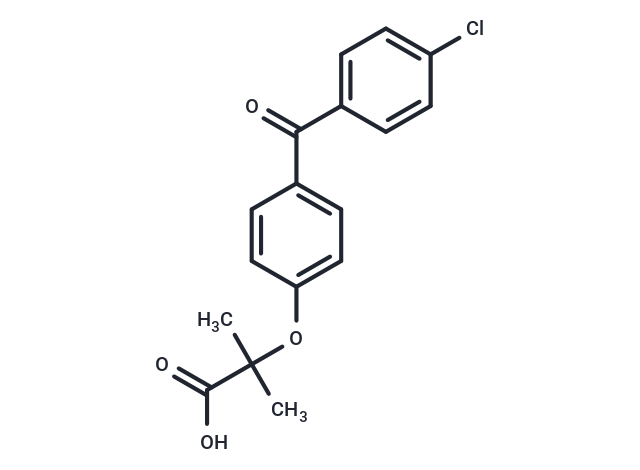Shopping Cart
- Remove All
 Your shopping cart is currently empty
Your shopping cart is currently empty

Fenofibric acid (FNF acid) is the active form of fenofibrate, a synthetic phenoxy-isobutyric acid derivate with antihyperlipidemic activity.

| Pack Size | Price | Availability | Quantity |
|---|---|---|---|
| 1 g | $31 | In Stock | |
| 5 g | $68 | In Stock | |
| 1 mL x 10 mM (in DMSO) | $29 | In Stock |
| Description | Fenofibric acid (FNF acid) is the active form of fenofibrate, a synthetic phenoxy-isobutyric acid derivate with antihyperlipidemic activity. |
| Targets&IC50 | COX-2:48 nM, PPARγ:1.47 µM(EC50), PPARα:22.4 µM(EC50), PPARδ:1.06 µM(EC50) |
| In vitro | Fibric acids, active forms of fibrate drugs and activators of peroxisome proliferator-activated receptor-alpha (PPARα), are also known for an HDL-raising effect. Fibric acids enhance fatty acid catabolism and accordingly reduce plasma lipid level, predominantly triglyceride (TG). Fenofibric acid increases the expression of ABCA1 and apoA-I–mediated HDL production. The effect on ABCA1 expression was through the enhancement of the transcription of the ABCA1 gene being dependent on LXR[1]. |
| In vivo | Fenofibric acid attenuates aberrant increases of circulating EPC(Endothelial Progenitor Cells) in OIR mice. Inhibitory effect of Fenofibric acid on EPC mobilization in the OIR model is PPARα-dependent.Fenofibric acid Inhibits hypoxia-induced retinal EPC increase in a PPARα-dependent manner. Fenofibric acid decreases CXCR4-positive EPC in the circulation, downregulates the serum SDF-1 level and suppresses HIF-1a and SDF-1 overexpression in the retina[1]. |
| Cell Research | PPAR activators fenofibric acid is dissolved in DMSO and added to the culture medium containing 0.2% BSA. RAW264 cells are washed with PBS and cultured an additional 48 hours in the presence of fenofibric acid in DMEM/F-12(1:1) medium containing 2% TCM and 0.2% BSA. During the last 24 hours of the drug treatment, 300 mol/L of dibutyryl cAMP and apoA-I (10 μg/mL) are added to the medium. THP-1 cells are also treated with the compound and apoA-I in 0.2% BSA-RPMI 1640 medium and 0.1% BSA-MEM. Cholesterol and choline-phospholipid released into the medium by apoA-I are determined enzymatically. Adherent cells are dissolved in 0.1 N NaOH for protein determination by bicinchoninic acid protein assay system. (Only for Reference) |
| Alias | Trilipix, NSC 281318, FNF acid |
| Molecular Weight | 318.75 |
| Formula | C17H15ClO4 |
| Cas No. | 42017-89-0 |
| Smiles | C(=O)(C1=CC=C(OC(C(O)=O)(C)C)C=C1)C2=CC=C(Cl)C=C2 |
| Relative Density. | 1.286 g/cm3 |
| Storage | Powder: -20°C for 3 years | In solvent: -80°C for 1 year | Shipping with blue ice. | |||||||||||||||||||||||||||||||||||
| Solubility Information | DMSO: 60 mg/mL (188.24 mM), Sonication is recommended. | |||||||||||||||||||||||||||||||||||
Solution Preparation Table | ||||||||||||||||||||||||||||||||||||
DMSO
| ||||||||||||||||||||||||||||||||||||

Copyright © 2015-2025 TargetMol Chemicals Inc. All Rights Reserved.